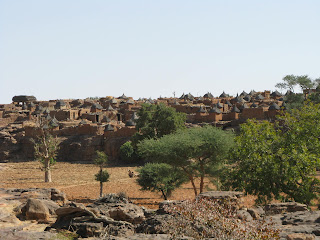Without question the Dogon region is Mali's biggest tourist destination. Dogon country, as it is referred, includes hundreds of small villages neslted along a huge escarpment, about 50 miles east of the city of Mopti. It is a truely magical part of Africa with some extremely isolated hamlets positioned high atop the cliffs, and long deserted ruins of the mysterious Tellem people scattered everywhere along the cliff, most of them hundreds of feet above the ground on extremely steep and smooth rock.
We began our trip with a visit to the mountain top town of Bandjougou, located about 25 km from Sevare, a short climb off of the main paved road to Bandiagara.
We found this town to be very beautiful. All of the houses are constructed of stone, and the town, perched on the edge of a cliff, looks down on huge millet fields.
Looking west from Bandjougou toward Goundaka
Looking East with millet fields in the valley below.

From Bandjougou we moved on to Bandiagara for a quick lunch and then proceeded out to the escarpment to visit the cliff-side dogon villages of Teli and Ende. These towns are frequented by tourists, and for good reason. They sit below spectacular cliff ruins, some of which were only abandoned within the past decade.
Looking up at the old village of Teli from the new village, and a view of the present village of Teli from above.(Note some of the ancient Tellem ruins high above!)
Our final day in Dogon country turned out to be our most ambitious. A 6+ mile hike that began with a steep hike up through bands of ledge to the top of the escarpment, and weaved us through the tiny isolated Dogon villages of Indelou and Begni Mato.






Gueladio had a falling out with his first cousin, who happened to be the powerful Muslim cleric, Sekou Amadou of Hamdallaye. In order to prevent a major split in the Fulani leadership, Sekou Amadou gave Gueladio a special stick and told him to leave Gundaka, and Mali, and not to stop until Gueladio was able to break the stick. After several months traveling through the bush, Gueladio snapped the stick in a small valley in what is now southern Niger. Gueladio settled in this valley and named it Kanari Keyri (the new Kanari). About 200 years later, in 1990, this village was to become my home when I served as a Peace Corps volunteer.
The villagers in Goundaka were were very hospitable and were excited to learn stories about some of their distant relatives in Kanari Keyri. Economic hardships have prevented anyone from Goundaka from visiting Ouro Gueladio for over a decade, and the same holds true for people in Ouro Gueladio. In fact, I met only one man who recalled traveling to Kanari Keyri, when he was a small boy in Koranic school.
A rough night camping in the back of the truck on the way back from the Dogon. Good thing we had our "Thomas the Train" pillow!
Forget about the Dogon, where is my remote-control truck?
Gus' favorite expression "Now this is what I'm talkin' about!"
Swimming in Teryia Bugu on New Years Eve Day... Not quite as bold as jumping into a frozen lake!



































No comments:
Post a Comment